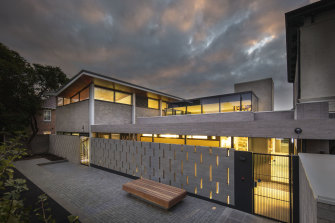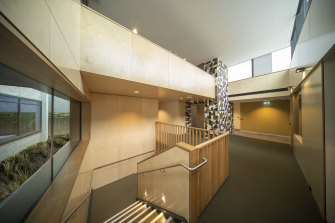Blink and you’ll miss it: new Myer Music School ‘recessive’
By Stephen Crafti
The new addition to The Myer Music School at Melbourne Grammar School is easy to miss.
Tucked away between Bromby House and the Myer Music School, the new building linking the two designed by Peter Elliott Architecture + Urban Design is remarkably recessive.

New bridges/walkways connect on one side, and on the other, access is via original Victorian decorative plastered arches.Credit:John Gollings
Given the functional brief given to the architects that included several recital rooms, the ability to achieve a recessive design is also remarkable.
“From the outset we were mindful of not wanting to overshadow either of the bookend buildings,” says architect Peter Elliott, director of the practice, who was also given the task of reworking both to create a larger music centre for the school.
Back in the 1860s, Bromby House, on the corner of Bromby Street and Domain Road in South Yarra, occupied the entire block down to Toorak Road.
Formerly home to the school’s music master and more recently used exclusively for recital rooms and offices, it was lightly restored and touched by Elliott and his team.
And what was formerly the home’s back garden is now the new extension that bridges the early 1960s with the 1860s.
“The land wasn’t being used and most would have simply walked past a worn timber paling fence,” says Elliott.
Many would be familiar with Mockridge Stahe & Mitchell’s distinctive Myer Music School concrete block building, with its butterfly-shaped roof (a contrast to the other pitched rooflines in the streetscape).
Although it was in reasonably good condition, including the original graphic tiles at the entrance, the recital rooms were in need of an update, with greater acoustic measures, for example.
One of the delightful characteristics of the early 1960s building is the concrete breezeblock fence that allows for a glimpse beyond. What was formerly a back garden is now a two-level wing that opens up to the existing buildings either side.
New bridges/walkways connect on one side, and on the other, access is via original Victorian decorative plastered arches.
The seamless connection between the two is a similar style concrete block breezeway/front fence, with the forecourt adjacent to the pavement featuring corbelled bluestone and a simple Japanese timber bench (evocative of the early 1960s).
Elliott also aligned the concrete fascia of this new wing to the verandah of the Victorian home to further “cement” this unison.

A double-height void in the reception area alludes to the spaces found in the buildings either side.Credit:John Gollings
But it’s only past this threshold that the contemporary design unfolds, including plywood walls and a lift core finished with graphic tiles in tones of brown, charcoal and cream, evocative of the early 1960s, but clearly moving onto the present.
A double-height void in the reception area alludes to the spaces found in the buildings either side.
Elliott also used the latest materials, such as studded rubber floors to improve both the acoustics as well as provide soft and tactile flooring under foot.
“Most of the rooms have been either double or triple glazed,” says Elliott, who also included built-in air conditioning in the perforated timber walls to ensure that doors could remain closed during practice times.
The Mockridge Stahle & Mitchell wing, now boasts a sophisticated recording studio/office.
As the number of recital rooms required by Melbourne Grammar School was considerably larger than the size of the former back garden, Elliott excavated below ground level to create two generous and also separate, larger recital spaces.
Here, you’ll discover fluted plywood walls evocative of the nearby curtains, along with fabric-covered walls that further insulate these studios.
And what could be more sound proof than “burying” both of these studios below ground level, with no noise heard from those passing by.
For Elliott, this project was seen as “companion” architecture to these buildings on the corner allotment.
“I was extremely mindful of the new wing’s relationship to the street, opting for a gentler approach.”
And locals can be easily forgiven for passing it by, even though it’s a delightful, yet recessive, addition to the streetscape.